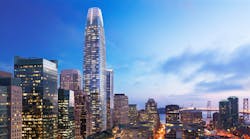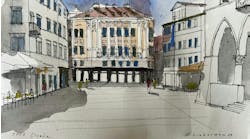The iconic skyline of San Francisco has a new defining feature with the recent opening of the 61-story Salesforce Tower. As the tallest office building in the U.S. west of Chicago, it serves as the new headquarters for one of the world’s fastest growing software companies. It also acts as the centerpiece of Salesforce’s urban headquarters campus in the city while raising the bar for sustainability standards.
All Photography Courtesy of Salesforce
The office space design creates clear sight lines and open flow on each floor to allow employees access to the best sunlight and views, inspiration from nature and sustainable materials. Among the design strategies chosen to help realize these benefits and features was the decision to install raised access floors throughout Salesforce Tower.
interiors+sources recently spoke with Mark Johnson, national sales director for Tate Access Floors, about the role raised flooring played in the design and operations of this innovative, sustainable new building.
interiors+sources: How did Tate Access Floors get involved in the Salesforce Tower project?
Mark Johnson: That building initially was a competition between a few design-build teams. One of the teams included Hines as the developer and their architect was Pelli Clark Pelli – and they won that competition. Hines, in its design as part of the base building, had raised floor designed into it so tenants could benefit from underfloor air distribution, number one. And then the flexibility of being able to run power, data, plumbing and everything else under the raised floor was another reason we were chosen. Then, as they leased out space, we were basically fitting out floor-by-floor working closely with the different tenants because we offer a variety of raised floor panels with different finishes on them. So, we would wait until a tenant was signed up, we would meet with their interior architect and finalize what exactly was going in that building in terms of the raised floor.
We want to help you grow your brand. Email us now to get started!
i+s: So it wasn’t a one-size-fits-all approach to the flooring throughout the Salesforce building?
MJ: The base design of the building features our ConCor 1500 welded steel cement-filled panel, and then that can change depending on the tenant’s needs. Our typical ConCor panel has traditionally been covered up with carpet tile, so people can lift up the carpet tile, get into the raised floor and make their changes or moves. Well, there’s definitely a trend going on where people are starting to use more hard finishes and that led to investing in and developing raised floor options with various hard finishes. Today, we have exposed concrete, porcelain, terrazzo and wood. And a number of the [Salesforce Tower] tenants, once it went into design, in their circulation areas, they might go concrete or terrazzo, and out in the open office area most of them would go with carpet tile. We also did wood, and we did porcelain in Salesforce, so that was unique to that building.
i+s: What are some of the benefits of specifying raised access floors for a project of this scope?
MJ: Number one is flexibility – the ability to bring power, data or HVAC anywhere you want it at the floor level and to be able to reconfigure that as your space changes. […] Putting it all on top of the slab under a raised floor, I can put it anywhere; I can reconfigure it, and I can use modular, prefabricated power systems that are all made in the factory. I just lay them on the slab and add to it or reconfigure it as needed. It’s not conduit, it’s not cell deck in the slab, it’s not overhead in a ceiling plenum; it’s all plug-and-play under my feet.
Another benefit of putting the air under the floor instead of ducted overhead allows you to save energy, because under the floor you provide a higher temperature air than overhead. Overhead, they typically are making 55-degree air and they’re putting a lot of horsepower and fan energy behind it to blow it through the ducts and down from the ceiling. And the 55-degree air mixes with the 80-degree air that’s at the ceiling and you hope you get 70 or 72 degrees. In underfloor, you supply 63- or 65-degree air so you have a 10-degree energy savings there. And the whole floor is a wide-open plenum, so it’s very low pressure as compared to the pressure you need to pump all that air through duct work.
I Hear Design: The interiors+sources PodcastFinally, when you talk about daylighting and views, there’s a big benefit there with natural lighting, obviously – there’s an energy savings as much as it is a more desirable lighting effect and views you can put into the whole biophilia bucket. […] So raised flooring supports and really goes hand-in-hand with the open-plan concept and daylighting [because] I can raise my ceiling higher and now expose more glass. I can get rid of my drop ceiling, which is what more people are doing, and now I can take my glass literally up to the main structure beams at the perimeter of the floor plate. You can start getting 10, 11 feet of glass. All of that plays into that raised floor potential of eliminating the ceiling, eliminating the walls and providing better daylighting and better views.







